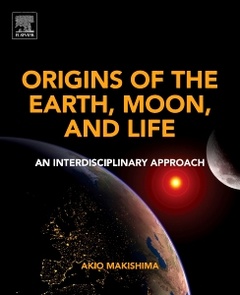Origins of the Earth, Moon, and Life An Interdisciplinary Approach
Auteur : Makishima Akio

Origins of the Earth, Moon, and Life: An InterdisciplinaryApproach presents state-of-the-art knowledge that is based on theories, experiments, observations, calculations, and analytical data from five astro-sciences, astronomy, astrobiology, astrogeology, astrophysics, and cosmochemistry.
Beginning with the origin of elements, and moving on to cover the formation of the early Solar System, the giant impact model of the Earth and Moon, the oldest records of life, and the possibility of life on other planets in the Solar System, this interdisciplinary reference provides a complex understanding of the planets and the formation of life.
Synthesizing concepts from all branches of astro-sciences into one, the book is a valuable reference for researchers in astrogeology, astrophysics, cosmochemistry, astrobiology, astronomy, and other space science fields, helping users better understand the intersection of these sciences.
1. Origin of Elements2. Formation of the Proto-Earth in the Solar Nebula3. The Giant Impact Made the Present Earth–Moon System4. What Is the Late Veneer, and Why Is It Necessary?5. The Age of the Moon6. Age of the Earth From Geological Records Remaining on the Earth Surface7. Life on Mars From the Martian Meteorite?8. The Hadean and Archaean Atmosphere and the Oldest Records of Life as Micro- or Chemofossils9. How Did Initial Life-Related Molecules Appear on Earth?10. From Life-Related Molecules to Life11. Possibility of Life on Other Planetary Bodies in Our Solar System12. Conclusions
Researchers in astrogeology, astrophycics, cosmochemistry, astrobiology, astronomy, and other space science fields
- Includes extensive figures and tables to enhance key concepts
- Uses callout boxes throughout to provide context and deeper explanations
- Presents up-to-date information on the universe, stars, planets, moons, and life in the solar system
- Combines knowledge from the fields of astrogeology, astrophysics, cosmochemistry, astrobiology, and astronomy, helping readers understand the origins of the Earth, the moon, and life in our solar system
Date de parution : 02-2017
Ouvrage de 268 p.
19x23.3 cm
Thème d’Origins of the Earth, Moon, and Life :
Mots-clés :
Age of the Moon; Akilia island; ALH84001; Amino acid synthesis; Amino acids; Apex chert; Archaea; Archaean atmosphere; Atmosphere; Bacteria; Big bang; Bright spot of Ceres; Callisto; Carbon isotope ratios; Carbonate globules; Cassigni; Cell cycle; Cell membrane; Ceres; Charon; Collision between ice; Core of zircon; Core; Cosmic origin; Crust; Curiosity; Cytoplasm; Deep ocean of the Earth; Double helix; Element synthesis; Enceladus; Enzyme; Eu anomaly; Eukaryote cell; Europa; FAN; Floating plagioclase; Fluid fractures; Ganymede; Gas gun experiments; Giant impact; Grand Tack model; Graphite; Hadean atmosphere; Highly siderophile element; High-pressure-temperature experiments; HSE; Hydrogen bond; Hydroxyl alcohols; Icy planet/icy planet or Earth collisions; Impact shock experiments; Impact shock origin; Io; Isotopic fractionation; Isua supracrustal belt; Isua; Jack Hills zircons; Jupiter; KREEP (enrichment in K; REE and P)Mafic cumulates; Laser-induced breakdown; Late heavy bombardment; Late veneer; LHB; Life-related molecules; Liquid water; Magma ocean; Mars; Martian meteorite; Meteorite; Mg-suite; Microfossil; Microfossils; Miller experiment; Molphological similarity; Moons of Jupiter; Moons of Saturn; Nanobacteria; NASA; Nice model; Nucleobase synthesis; Nuvvuagittuq green belt; Oxygen isotopic fractionation; PAHs; Peptide world; Peptide+nucleic acid world; PGE; Pilbara area; Planets; Platinum group element; Pluto; Primitive upper mantle; Proteins; Protocell; PUM; Purines; Pyrimidines; Reproduction of cell; Reproduction; RNA world; RSD; Saterites; Saturn; SD; SE; Shock-recovery experiments; SIMS; Space telescopes; Spacecrafts; Standard deviation; Star; Statistics; Storage of genetic information; Supernova; The Apollo program; The giant impact; The oldest crust; The oldest zircon; The proto-Earth; Titan; Transportation on the Earth; Ujaraaluk; Vesta; West Greenland; White dwarf; Xenology; Zircon



